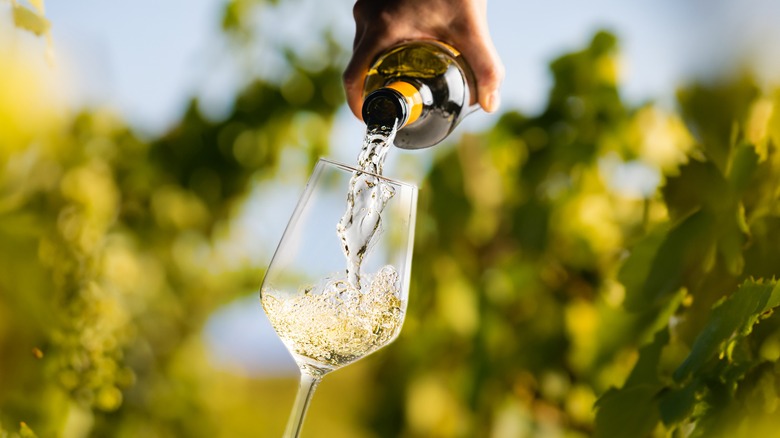What Does Acidity Refer To In Wine?
When we describe wine, it's important to use specific language. Some descriptors are based on taste, while others are rooted in the science of wine-making. The term "acidic" falls into the second category, but it's often used incorrectly, usually by interchanging it with words like "dry" or "tannic." But these are all actually distinct properties of wine. It's important to understand what "acidity" really means in this context. Plenty of fruits contain natural acids, and grapes are no different. However, some grape varieties are more acidic than others. As grapes ripen in the sun, they start to produce more sugar, and their acidity level drops. Grapes that are harvested earlier in the season are likely to be more acidic and less sweet.
You can usually tell if a wine is acidic from the first sip; if you can feel your mouth start to salivate, that's an indication of good acidity. If a wine's acidity is balanced, it should taste bright, and refreshing — "zippy" is one way of describing it. If a wine is too acidic, it might taste tart or sour, like fresh citrus juice. On the flip side, a wine with low acidity will taste smoother — but this isn't always a desirable quality.
What wines have high acidity?
While every wine has its own unique features, some styles are typically more acidic than others. There are a few different factors that can affect both the real and perceived acidity of wine. White wines are usually talked about as having higher acidity. Indeed, acidity is often referred to as the backbone of white wine, as it helps balance the other main flavor components: sweetness, alcohol, body, and tannins. Some white wine styles, like Sauvignon Blanc, Chenin Blanc, or Riesling, are known for their higher acidity. However, varieties like Chardonnay or Viognier have a medium-to-lower acidity.
Red wines can also have high acidity, but there's a reason whites are seen as more reliant on it. When red wine is made, the grapes are left in contact with their skins, which contain tannins. If the wine is then aged in a barrel, the wood will impart even more tannins to the wine. Where an acidic wine makes your mouth water when you take a sip, tannins do the opposite, making the inside of your mouth pucker. That said, even though it might feel like it's drying your mouth out, this isn't what we mean when we call a wine "dry." In this case, dry means "not sweet." Red wines like Pinot Noir have high acidity, but this tends to be less noticeable than in white wines because tannins play a larger role in the tasting experience.
How does wine acidity affect food pairing?
Now you know what acidity refers to in wine, what causes it, and how to identify it. However, there's one more crucial thing to cover: the best way to pair acidic wine with food.
In the culinary world, acid does more than just add a sour flavor to something. In fact, you won't often be able to identify acid by its presence, but by the balance it provides to other flavors. Acid can brighten a dish, but it can also provide a sharp contrast that's perfect for creamy foods. It's superb for cutting through rich and fatty dishes, refreshing the palate between each bite. Acidic wine is also — as you might guess — good for boosting the acidity of the dish, like in a lemon-based sauce.
Consider the way white wine pairs with seafood. Style plays a huge role: An acidic wine like Chenic Blanc is the best pairing for buttery lobster tails, whereas a Chardonnay might not lift the flavors as effectively. If you've got a less delicate fish with a higher fat content, you can even go for a red wine. For example, a bright, acidic Pinot Noir can be the perfect complement to salmon. One thing to bear in mind is that balancing flavors is a nuanced affair. So, while an acidic wine is good for balancing mildly sweet foods, matching one with a super sugary dessert may make the tartness too prominent.


